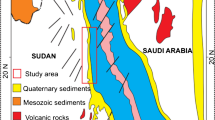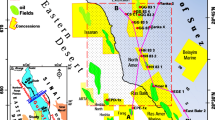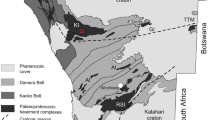Abstract
Tiran and Sanafir islands and their surrounding areas are very important due to their location within the Red Sea, which is in a triple junction among the African and Arabian plates and the Sinai Peninsula microplate. Consequently, this area should be studied from a geological point of view, particularly because there is a plan to construct King Salman’s bridge connecting Egypt and Saudi Arabia. Freely available potential field data, such as magnetic and gravity data, were integrated with seismological data from nearby seismic stations to understand the regional structure and seismic activity in the area. Potential field data were analysed using edge detection techniques (Tilt DeRivative and horizontal gradient) for qualitative interpretation and 2D inversion modelling for quantitative interpretation. Seismological data were analysed geostatistically to identify many epicentre locations and estimate the focal depths. The results of the potential field data analysis indicate that Tiran and Sanafir islands are located along a subsurface geological edge trending NW, parallel to the Red Sea. A similarity in potential field anomalies between both islands and the southern Sinai Peninsula indicates that these islands were separated from the Sinai Peninsula during the formation of the Gulf of Aqaba via Dead Sea Transform fault. The analysis of the seismic data indicates that a specific motion characterizes each focal depth solution. The seismic events are related to main structural trends NW–SE and NE–SW.









Similar content being viewed by others
References
Abdel-Fattah AK, Hussein HM, Ibrahim EM, Abu El Atta AS (1997) Fault plane solutions of the 1993 and 1995 Gulf of Aqaba earthquakes and their tectonic implications. Ann Geophys 40(6)
Benavraham Z (1985) Structural framework of the Gulf of Elat (Aqaba), Northern Red-Sea. J Geophys Res Solid Earth Planets 90(Nb1):703–726
Bosworth W, Taviani M (1996) Late quaternary reorientation of stress field and extension direction in the southern Gulf of Suez, Egypt: evidence from uplifted coral terraces, mesoscopic fault arrays, and borehole breakouts. Tectonics 15(4):791
Chu DZ, Gordon RG (1998) Current plate motions across the Red Sea. Geophys J Int 135(2):313–328
Daggett PH, Morgan P, Boulos FK, Hennin SF, Elsherif AA, Elsayed AA, Basta NZ, Melek YS (1986) Seismicity and active tectonics of the Egyptian Red-Sea margin and the Northern Red-Sea. Tectonophysics 125(4):313–324
Förste C, Bruinsma SL, Flechtner F, Marty J, Lemoine JM, Dahle C, Abrikosov O, Neumayer H, Biancale R, Barthelmes F (2012) A preliminary update of the direct approach GOCE processing and a new release of EIGEN-6C. In: AGU Fall meeting abstracts, pp 923
Geosoft (2017) Geosoft desktop application. Geosoft Inc., North America, Canada
Goldberg M, Beyth M (1991) Tiran Islan: an internal block at the junction of the Red Sea rift and Dead Sea transform. Tectonophysics 198:14
Hamouda AZ (2011) Recent evaluation of the assessment seismic hazards for Nuweiba, Gulf of Aqaba. Arab J Geosci 4(5):775–783
Hegazi MM, Abdel-Rahman IF, Aboulela H (2006) An overview of earthquake pools in Ras Muhammad area, South Sinai, Egypt. Egypt J Geol 50:339–349
Hempton MR (1987) Constraints on Arabian plate motion and extensional history of the Red-Sea. Tectonics 6(6):687
Hofstetter A, Bock G (2004) Shear-wave velocity structure of the Sinai subplate from receiver function analysis. Geophys J Int 158(1):67–84
Hood P (1965) Gradient measurements in aeromagnetic surveying. Geophysics 30(5):891–902
Joffe S, Garfunkel Z (1987) Plate kinematics of the circum Red-Sea: a reevaluation. Tectonophysics 141(1–3):5–22
Kebeasy R (1990) Seismicity, geology of Egypt. Elsevier, Amsterdam, p 377
Lyberis N (1988) Tectonic evolution of the Gulf of Suez and the Gulf of Aqaba. Tectonophysics 153(1–4):209–220
Mahmoud S, Reilinger R, McClusky S, Vernant P, Tealeb A (2005) GPS evidence for northward motion of the Sinai Block: implications for E. Mediterranean tectonics. Earth Planet Sci Lett 238(1–2):217–224
Maus S, Barckhausen U, Berkenbosch H, Bournas N, Brozena J, Childers V, Dostaler F, Fairhead JD, Finn C, von Frese RRB, Gaina C, Golynsky S, Kucks R, Luhr H, Milligan P, Mogren S, Muller RD, Olesen O, Pilkington M, Saltus R, Schreckenberger B, Thebault E, Tontini FC (2009) EMAG2: A 2-arc min resolution earth magnetic anomaly grid compiled from satellite, airborne, and marine magnetic measurements. Geochem Geophys Geosyst 10:Q08005. doi:http://dx.doi.org/10.1029/2009GC002471
McClusky S, Reilinger R, Mahmoud S, Ben Sari D, Tealeb A (2003) GPS constraints on Africa (Nubia) and Arabia plate motions. Geophys J Int 155(1):126–138
Mckenzie DP (1970) Plate tectonics and continental Drift. Endeavour 29(106):39
Miller HG, Singh V (1994) Potential-field tilt: a new concept for location of potential-field sources. J Appl Geophys 32(2–3):213–217
Nur A, Benavraham Z (1978) Eastern Mediterranean and levant: tectonics of continental collision. Tectonophysics 46(3–4):297–311
Phillips JD (1997) Potentail-field geophysical software for the PC, U.S. Geological survey open-file-report 97-725. U.S. Geological Survey, p 34
Phillips JD, Hansen RO, Blakely RJ (2007) The use of curvature in potential-field interpretation. Explor Geophys 38(2):111–119
Steckler MS, Tenbrink US (1986) Lithospheric strength variations as a control on new plate boundaries: examples from the Northern Red-Sea region. Earth Planet Sci Lett 79(1–2):120–132
Talwani M (1964) Computation of magnetic anomalies caused by two dimensional structures of arbitary shape. Comput Miner Ind 1:464–480
Talwani M, Worzel JL, Landisman M (1959) Rapid gravity computations for two-dimensional bodies with application to the Mendocino submarine fracture zone. J Geophys Res 64(1):49–59
Verduzco B, Fairhead JD, Green CM, MacKenzie C (2004) New insights into magnetic derivatives for structural mapping. Lead Edge 23(2):116–119
Acknowledgements
This work was supported by the Deanship of Scientific Research (DSR), King Abdulaziz University, Jeddah, under Grant no. (D-183-150-1437). The authors, therefore, gratefully acknowledge the DSR technical and financial support.
Author information
Authors and Affiliations
Corresponding author
Rights and permissions
About this article
Cite this article
Aboulela, H.A., Aboud, E. & Bantan, R.A. Seismicity and major geologic structures of Tiran and Sanafir islands and their surroundings in the Red Sea. Environ Earth Sci 76, 793 (2017). https://doi.org/10.1007/s12665-017-7145-0
Received:
Accepted:
Published:
DOI: https://doi.org/10.1007/s12665-017-7145-0




